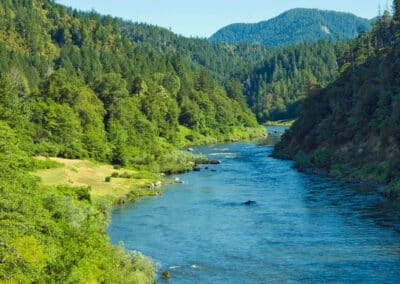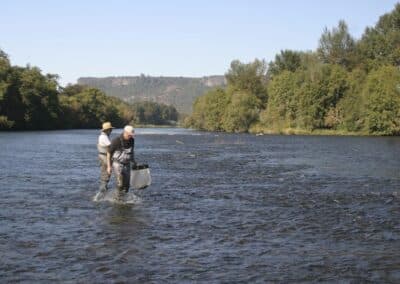Documents
Stay Informed
News
Oregon’s Rogue River
The Rogue River flows more than 200 miles from a spring emerging from the ground near Crater Lake to Gold Beach, on the Pacific Ocean. One of the original eight rivers protected by the Wild and Scenic Rivers Act of 1968, the Rogue is known for fishing, boating, and its aesthetic beauty. The Rogue River is home to a diverse variety of aquatic species—coho and chinook salmon, steelhead, green sturgeon, Pacific lamprey—many of which have been identified as “species of concern” by NOAA Fisheries or as “sensitive species” by the Oregon Department of Fish & Wildlife because of their depressed numbers. Coho salmon have been listed as threatened under the Endangered Species Act, and populations of spring Chinook are in precipitous decline. The most ubiquitous pollutant in the Rogue River basin is temperature caused, primarily, by polluted runoff from nonpoint sources such as logging and farming, along with reductions and changes in river flow caused by dams and irrigation withdrawals.
In 2018, NWEA sued the City of Medford in federal court for polluting the Rogue River in violation of its water pollution discharge permit. A year later, NWEA and Medford agreed to work together through a partial settlement of the case. As a result of the settlement, Medford issued a consultant’s report in April 2020 that agreed that its discharge of nutrient pollution—both nitrogen and phosphorus—is causing a multitude of water quality problems downstream. NWEA’s expert panel reviewed the report and issued its own rebuttal report, a scathing rebuke of the flawed methods of data gathering and analysis done by Medford’s consultant. Our expert report also recommends strict discharge limits for nitrogen and phosphorus in order to protect the Rogue River.
Rogue River Clean-Up Plans that Authorize Lethally Hot Water
The Oregon Department of Environmental Quality has issued numerous clean-up plans called Total Maximum Daily Loads (TMDLs) for the Rogue River and its tributaries, primarily focused on reducing temperature. TMDLs are not self-implementing so the creation of a TMDL does little if anything to change land practices that are causing pollution problems. Instead, the Oregon DEQ’s TMDLs have authorized much higher temperatures than would otherwise be allowed by the Clean Water Act. For example, according to Oregon’s water quality standards temperatures for salmon and steelhead should not exceed 16°−18° C (61°−64° F), but that didn’t stop the U.S. Environmental Protection Agency (EPA) from approving Oregon’s TMDLs that permitted Evans Creek to be 25° C (77° F ), the South Fork Little Butte Creek to be 23° C (73° F), and the Rogue River itself to become 27 °C (81° F). These temperatures are lethal to cold-water salmon through such effects as causing high rates of disease, loss of growth, and loss of swimming capacity.
In 2012, NWEA challenged EPA’s approval of three TMDLs for the Rogue River basin: the Rogue River Basin, Applegate Subbasin, and the Middle Rogue Subbasin & Bear Creek Watershed on the basis that the approvals also changed Oregon’s temperature standards in violation of the Clean Water Act. We won this case in 2017, and in 2018, the court agreed that the TMDLs were invalid and EPA’s plea to leave them in place for 12 years was unacceptable.
Bear Creek: Oregon DEQ’s Fake TMDL Success Story
The Rogue River basin’s Bear Creek—known as the home of pear and apple orchards dating from the 1860s—is touted by Oregon DEQ as proof that its TMDL program actually cleans up water quality. While water quality in Bear Creek has improved, it is not because of the TMDL, or due to any DEQ actions, or because agricultural nonpoint sources decided to voluntarily protect public waters. Instead, Bear Creek’s improved water quality is a result of tribal actions and drought in the nearby Klamath basin.
In 2001, a massive drought struck the Klamath River Basin. During the drought, the United States government followed federal and Oregon law and maintained water levels to protect imperiled coho salmon in the Klamath River and two species of suckers in the Upper Klamath Lake. The Klamath Tribes hold a water right that is superior to all other basin water rights and treaty rights to fish. In the 2001 drought, water was cut off to irrigators, not only in the Klamath but water transferred to the Rogue River basin to three irrigation districts. As a result, Bear Creek basin’s orchard farmers were forced to stop using wasteful flood irrigation, resulting in significant reductions in polluted runoff of phosphorus, the oxygen-depleting nutrient targeted in the 1992 Bear Creek TMDL. Until this forced improvements, the only significant progress in reducing phosphorus had been the 2002 City of Ashland sewage treatment plant upgrade, to remove phosphorus from its discharge. Of course, some farmers have chosen to reduce polluted runoff in order to protect their soils, to save money, or to protect public waters.

Ashland Sewage Permit Comments

Rogue River Court Victory

Cleaning Up the Rogue River: Update
| Court Order Medford Sept 2021 | October 21, 2021 | Court Order Medford Sept 30, 2021 Magistrate Judge Clarke’s Findings and Recommendation (ECF No. 58)... | Download |
| News Release Medford Win Sept 2021 | October 21, 2021 | New Release regarding the NWEA court win over the City of Medford. federal judge ruled that Medford is... | Download |
| Ashland NPDES Permit Comments Oct 2021 | October 18, 2021 | NWEA's Ashland NPDES Permit comments submit on October 18, 2021. Despite the length of time it has taken... | Download |
| Medford Summary Judgement 2021 | June 9, 2021 | Plaintiff is entitled to summary judgment on the First Claim for relief. A dispute of material fact prevents... | Download |
| NWEA v Medford Opening Brief | January 22, 2021 | Nutrient pollution is “one of America's most widespread, costly and challenging environmental problems,”... | Download |
| Medford Fact Sheet June 2020 | June 15, 2020 | Medford Fact Sheet regarding the City's report and status. Background & History 2011 Oregon Department... | Download |
| Rebuttal Report to Medford Nutrient Assessment | May 30, 2020 | NWEA Rebuttal Report to city of Medford's Nutrient Assessment in sum: Thus, Stillwater Sciences failed... | Download |
| Medford Nutrient Limit Assessment Report | March 24, 2020 | Medford Nutrient Limit Assessment Report Final March 24, 2020 Determine what degree of nutrient discharge... | Download |
| City of Medford Hume Report Feb 2019 | May 31, 2019 | City of Medford sponsored report to address issues raised by Northwest Environmental Advocates in its... | Download |
| Medford Mixing Zone Study April 2014 | May 31, 2019 | City of Medford study regarding mixing zones B and C in the Rogue River ... | Download |
